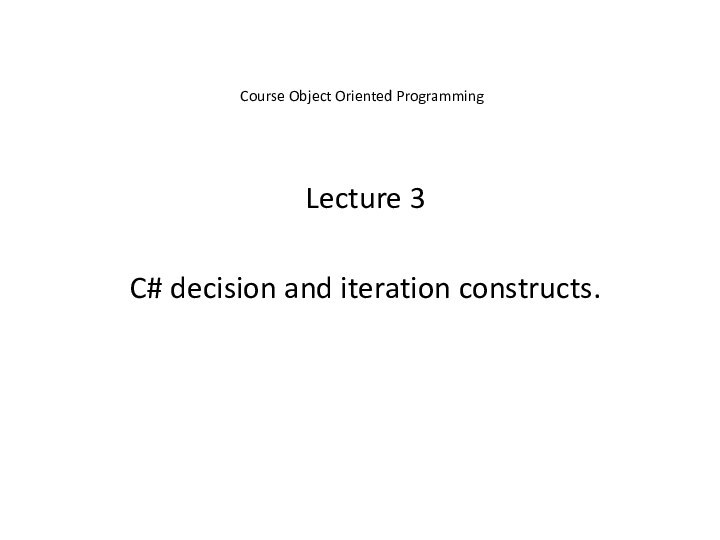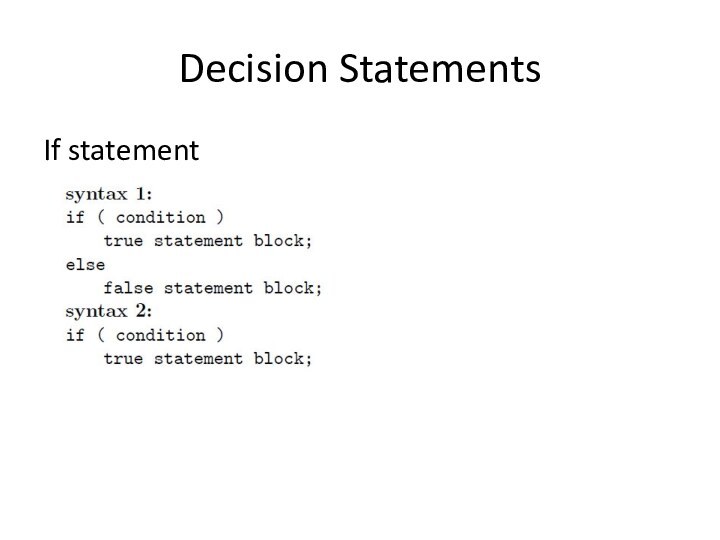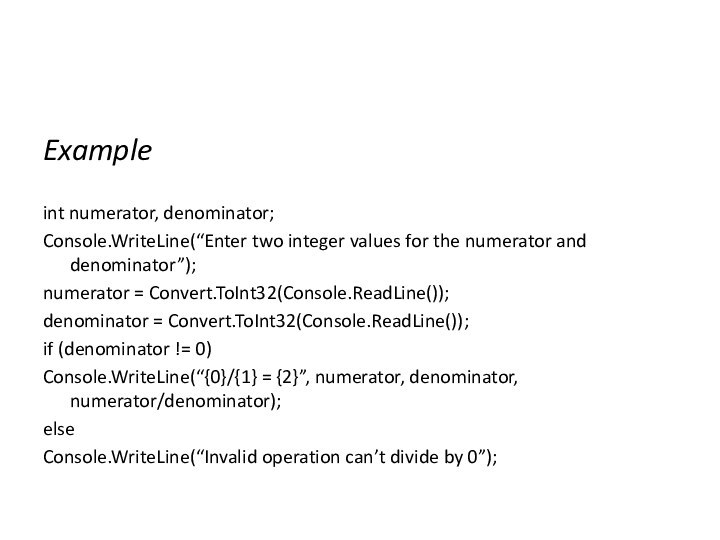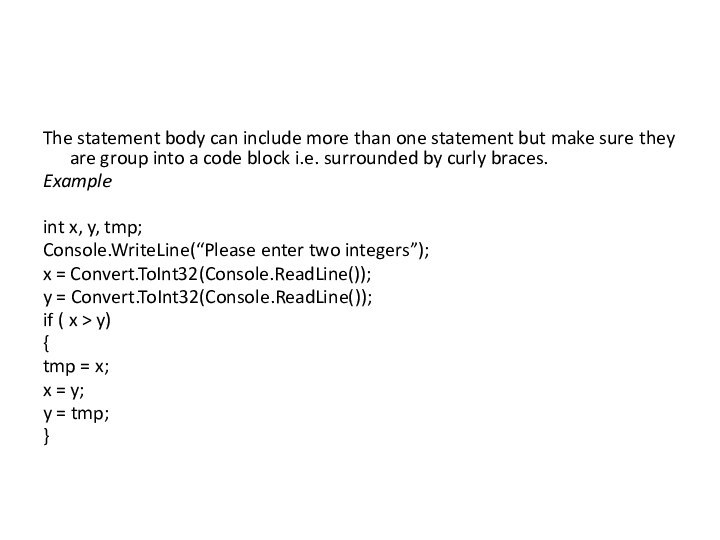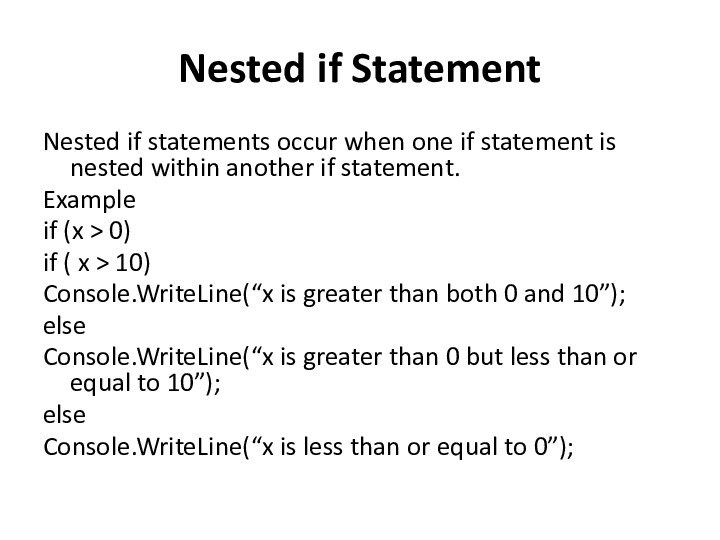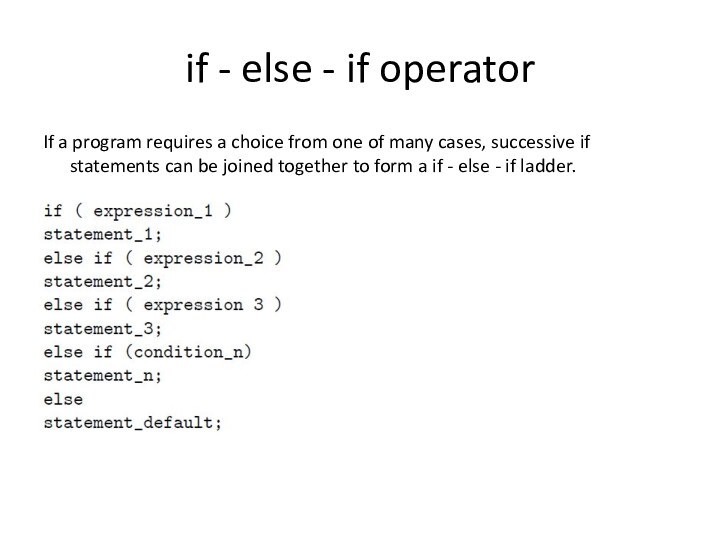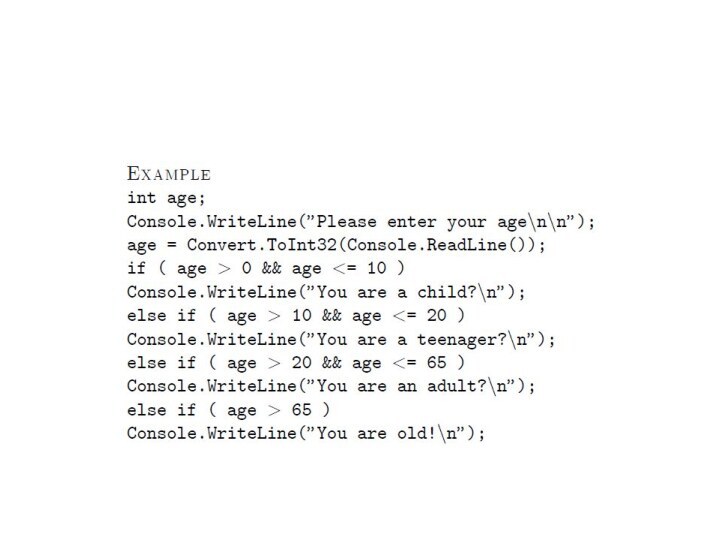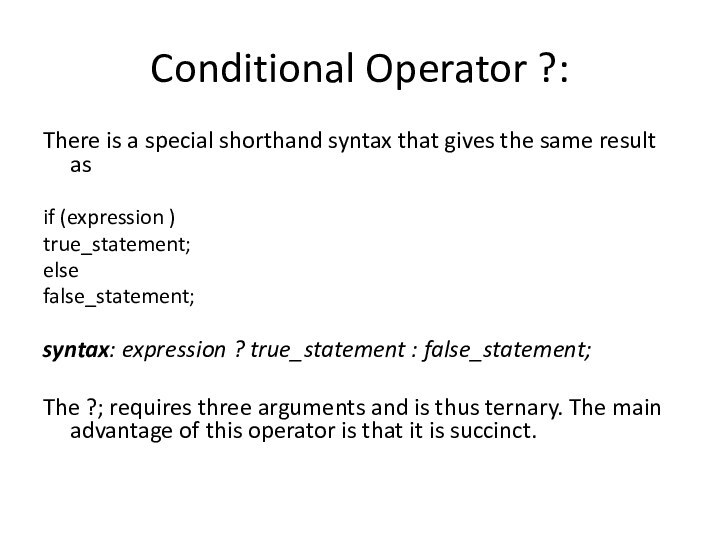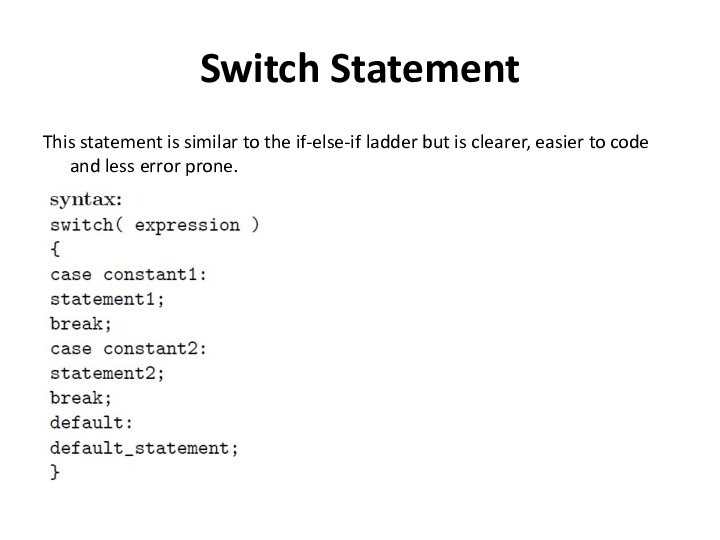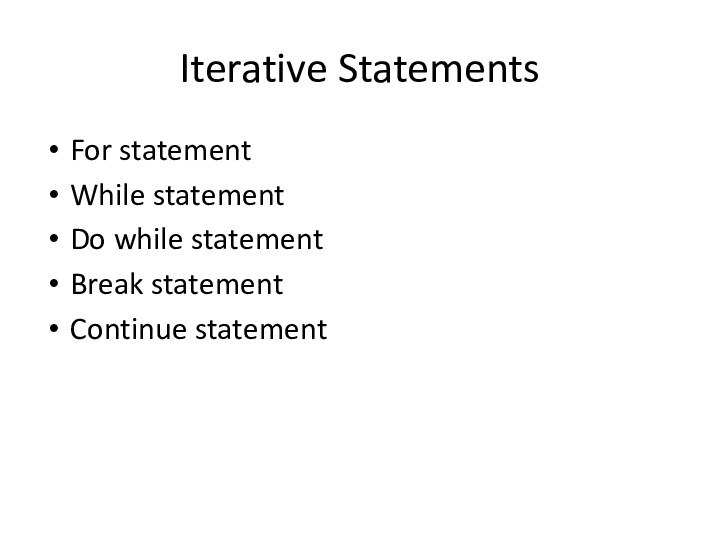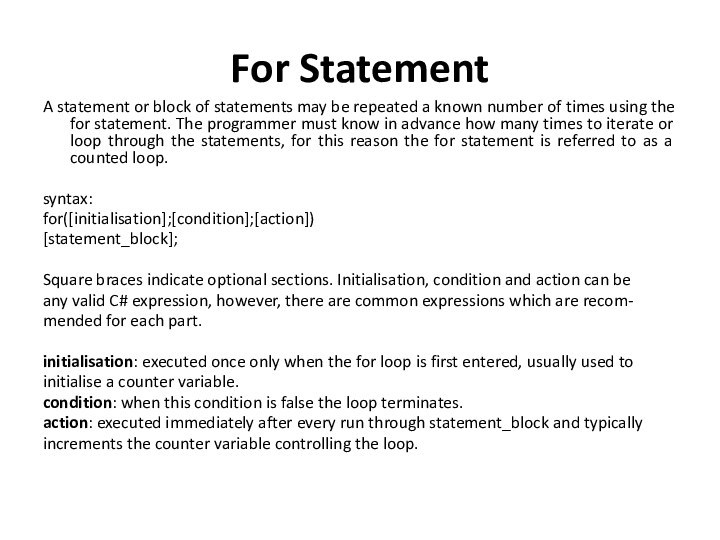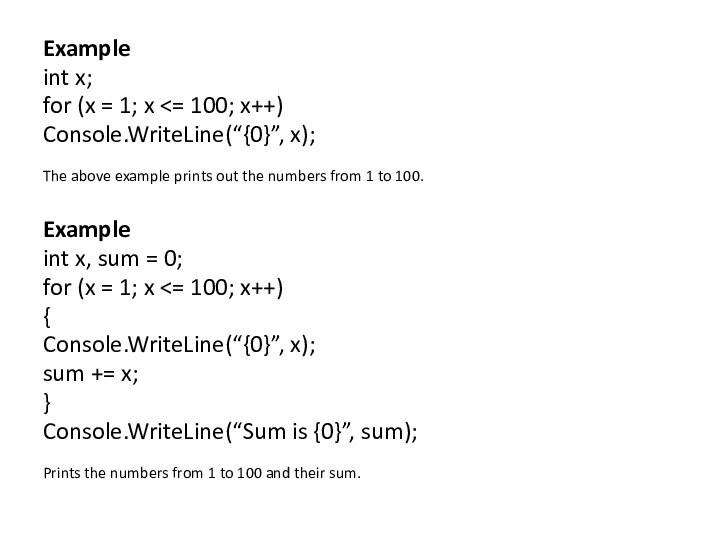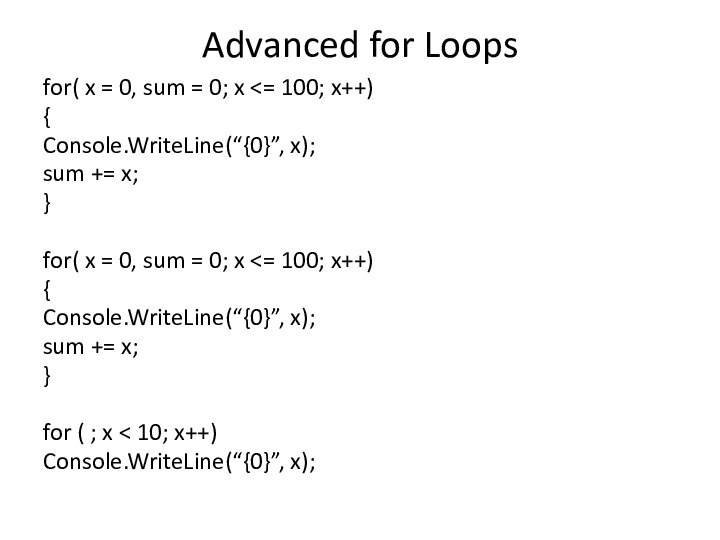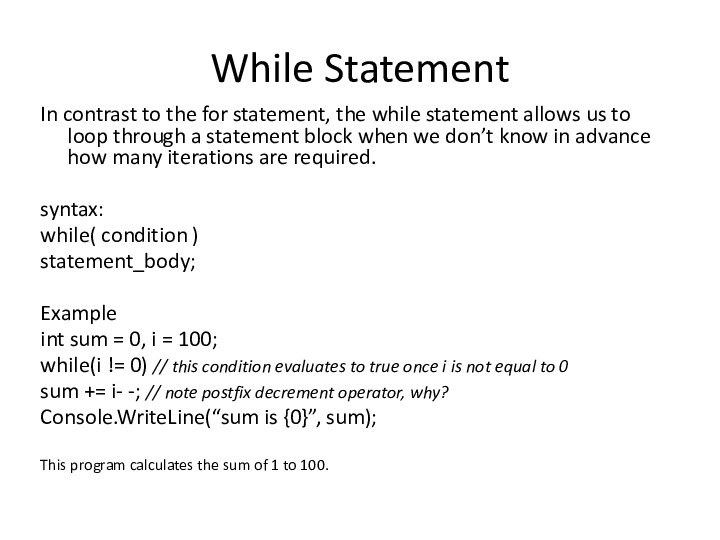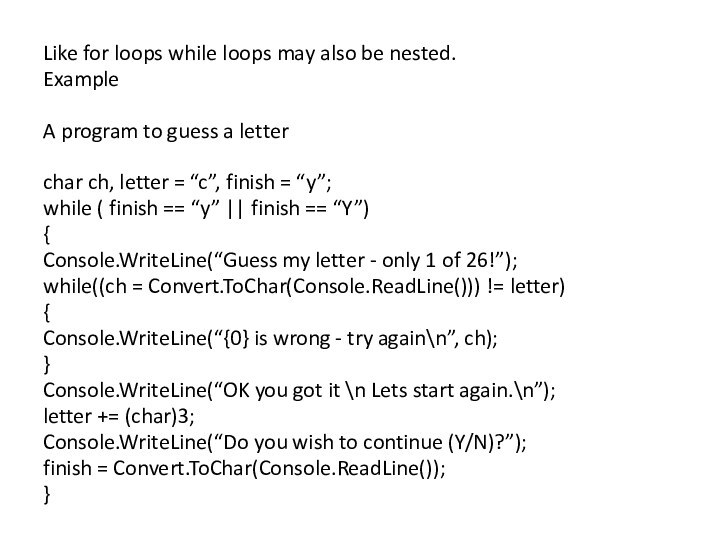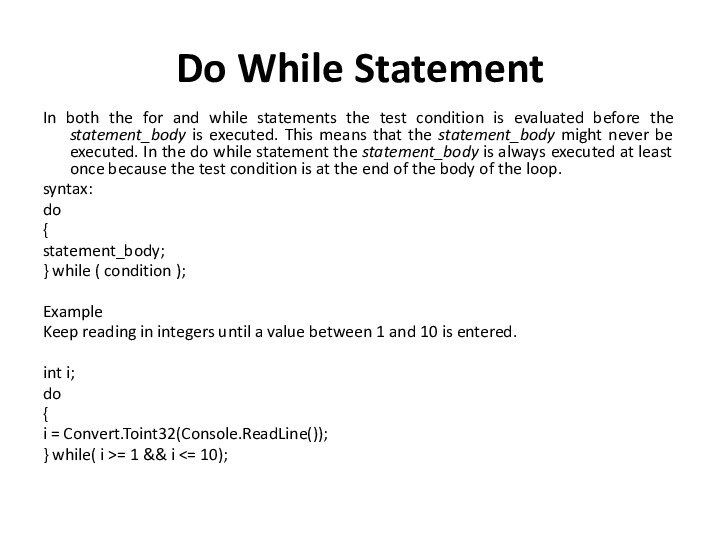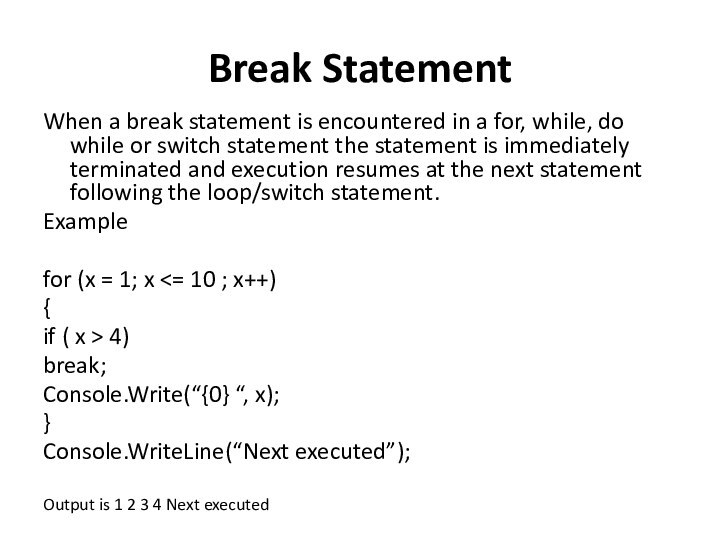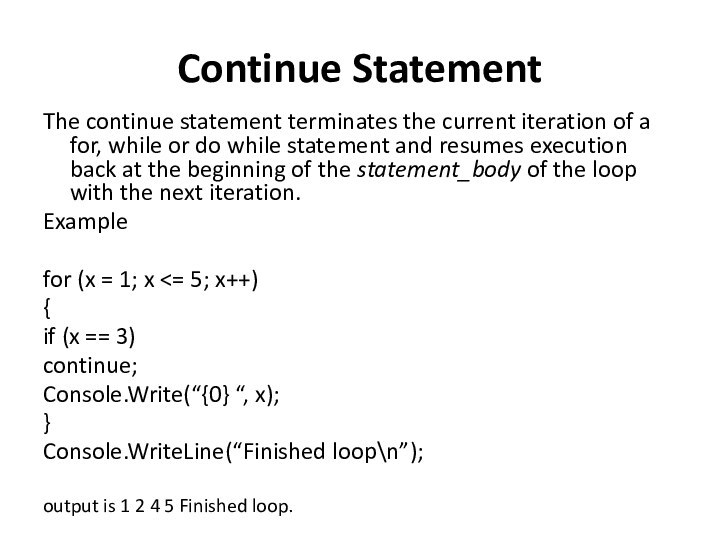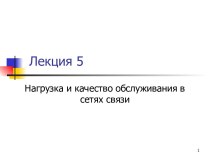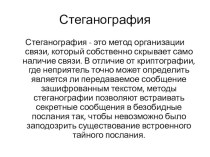Слайд 2
Decision Statements
If statement
Слайд 3
Example
int numerator, denominator;
Console.WriteLine(“Enter two integer values for the
numerator and denominator”);
numerator = Convert.ToInt32(Console.ReadLine());
denominator = Convert.ToInt32(Console.ReadLine());
if (denominator !=
0)
Console.WriteLine(“{0}/{1} = {2}”, numerator, denominator, numerator/denominator);
else
Console.WriteLine(“Invalid operation can’t divide by 0”);
Слайд 4
The statement body can include more than one
statement but make sure they are group into a
code block i.e. surrounded by curly braces.
Example
int x, y, tmp;
Console.WriteLine(“Please enter two integers”);
x = Convert.ToInt32(Console.ReadLine());
y = Convert.ToInt32(Console.ReadLine());
if ( x > y)
{
tmp = x;
x = y;
y = tmp;
}
Слайд 5
Nested if Statement
Nested if statements occur when one
if statement is nested within another if statement.
Example
if (x
> 0)
if ( x > 10)
Console.WriteLine(“x is greater than both 0 and 10”);
else
Console.WriteLine(“x is greater than 0 but less than or equal to 10”);
else
Console.WriteLine(“x is less than or equal to 0”);
Слайд 6
if - else - if operator
If a program
requires a choice from one of many cases, successive
if statements can be joined together to form a if - else - if ladder.
Слайд 8
Conditional Operator ?:
There is a special shorthand syntax
that gives the same result as
if (expression )
true_statement;
else
false_statement;
syntax: expression
? true_statement : false_statement;
The ?; requires three arguments and is thus ternary. The main advantage of this operator is that it is succinct.
Слайд 9
Example
max = x >= y ? x :
y;
which is the equivalent of
if ( x >= y)
max
= x;
else
max = y;
Слайд 10
Switch Statement
This statement is similar to the if-else-if
ladder but is clearer, easier to code and less
error prone.
Слайд 11
Example
double num1, num2, result;
char op;
Console.WriteLine(“Enter number operator number
\n”);
num1 = Convert.ToInt32(Console.ReadLine());
op = Convert.ToChar(Console.ReadLine());
num2 = Convert.ToInt32(Console.ReadLine());
switch(op)
{
case “+”:
result =
num1 + num2;
break;
case “-”:
result = num1 - num2;
break;
case “*”:
result = num1 * num2;
break;
case “/”:
if(num2 != 0)
{
result = num1 / num2;
break;
} //else fall through to error statement
default:
Console.WriteLine(“ERROR- invalid operation or divide by 0.0 \n”);
}
Console.WriteLine(“{0} {1},{2} = {3}\n”, num1, op, num2, result);
Слайд 12
Iterative Statements
For statement
While statement
Do while statement
Break statement
Continue statement
Слайд 13
For Statement
A statement or block of statements may
be repeated a known number of times using the
for statement. The programmer must know in advance how many times to iterate or loop through the statements, for this reason the for statement is referred to as a counted loop.
syntax:
for([initialisation];[condition];[action])
[statement_block];
Square braces indicate optional sections. Initialisation, condition and action can be
any valid C# expression, however, there are common expressions which are recom-
mended for each part.
initialisation: executed once only when the for loop is first entered, usually used to
initialise a counter variable.
condition: when this condition is false the loop terminates.
action: executed immediately after every run through statement_block and typically
increments the counter variable controlling the loop.
Слайд 14
Example
int x;
for (x = 1; x
100; x++)
Console.WriteLine(“{0}”, x);
The above example prints out the numbers
from 1 to 100.
Example
int x, sum = 0;
for (x = 1; x <= 100; x++)
{
Console.WriteLine(“{0}”, x);
sum += x;
}
Console.WriteLine(“Sum is {0}”, sum);
Prints the numbers from 1 to 100 and their sum.
Слайд 15
Advanced for Loops
for( x = 0, sum
= 0; x
x = 0, sum = 0; x <= 100; x++)
{
Console.WriteLine(“{0}”, x);
sum += x;
}
for ( ; x < 10; x++)
Console.WriteLine(“{0}”, x);
Слайд 16
Advanced for Loops
int i=100,sum=0;
while(i != 0)
sum
+= i- -;
Console.WriteLine(“sum is {0}”, sum);
Слайд 17
In contrast to the for statement, the while
statement allows us to loop through a statement block
when we don’t know in advance how many iterations are required.
syntax:
while( condition )
statement_body;
Example
int sum = 0, i = 100;
while(i != 0) // this condition evaluates to true once i is not equal to 0
sum += i- -; // note postfix decrement operator, why?
Console.WriteLine(“sum is {0}”, sum);
This program calculates the sum of 1 to 100.
While Statement
Слайд 18
Like for loops while loops may also be
nested.
Example
A program to guess a letter
char ch, letter =
“c”, finish = “y”;
while ( finish == “y” || finish == “Y”)
{
Console.WriteLine(“Guess my letter - only 1 of 26!”);
while((ch = Convert.ToChar(Console.ReadLine())) != letter)
{
Console.WriteLine(“{0} is wrong - try again\n”, ch);
}
Console.WriteLine(“OK you got it \n Lets start again.\n”);
letter += (char)3;
Console.WriteLine(“Do you wish to continue (Y/N)?”);
finish = Convert.ToChar(Console.ReadLine());
}
Слайд 19
Do While Statement
In both the for and while
statements the test condition is evaluated before the statement_body
is executed. This means that the statement_body might never be executed. In the do while statement the statement_body is always executed at least once because the test condition is at the end of the body of the loop.
syntax:
do
{
statement_body;
} while ( condition );
Example
Keep reading in integers until a value between 1 and 10 is entered.
int i;
do
{
i = Convert.Toint32(Console.ReadLine());
} while( i >= 1 && i <= 10);
Слайд 20
Break Statement
When a break statement is encountered in
a for, while, do while or switch statement the
statement is immediately terminated and execution resumes at the next statement following the loop/switch statement.
Example
for (x = 1; x <= 10 ; x++)
{
if ( x > 4)
break;
Console.Write(“{0} “, x);
}
Console.WriteLine(“Next executed”);
Output is 1 2 3 4 Next executed
Слайд 21
Continue Statement
The continue statement terminates the current iteration
of a for, while or do while statement and
resumes execution back at the beginning of the statement_body of the loop with the next iteration.
Example
for (x = 1; x <= 5; x++)
{
if (x == 3)
continue;
Console.Write(“{0} “, x);
}
Console.WriteLine(“Finished loop\n”);
output is 1 2 4 5 Finished loop.
